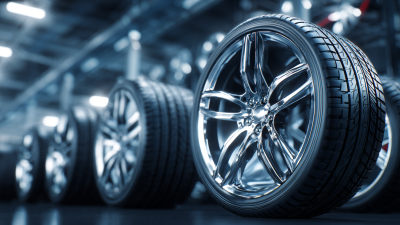Blog
Top 10 Essential Vehicle Parts Every Car Owner Should Know for Optimal Performance
Understanding the essential vehicle parts is crucial for every car owner who aims to ensure optimal performance and safety of their vehicle. According to a recent report by the Automotive Parts Manufacturers Association, the performance of a vehicle can be significantly impacted by the regular maintenance and awareness of key components. As industry expert Dr. Susan Harris, an automotive engineer and consultant, states,
“Knowledge of critical vehicle parts can not only enhance longevity but also improve overall driving experience.”
The modern automobile is a complex interplay of various systems, and having a grasp of the ten most essential vehicle parts empowers owners to make informed decisions about maintenance and repairs. For instance, studies indicate that nearly 70% of engine failures are linked directly to the neglect of vital parts like the oil filter and spark plugs. This underscores the importance of proactive management of vehicle parts to avoid costly breakdowns and ensure the vehicle remains in peak condition. By familiarizing yourself with these crucial components, you can enhance your vehicle’s performance and reduce the likelihood of unexpected issues.

The Importance of the Engine: Understanding Its Role in Vehicle Performance
The engine is the heart of any vehicle, serving as the primary source of power that propels the car forward. It converts fuel into mechanical energy through a series of complex processes, including combustion and energy transfer. Understanding how the engine operates and managing its upkeep can significantly enhance a vehicle's performance. Regular maintenance, such as oil changes, filter replacements, and coolant checks, ensures that the engine runs smoothly and efficiently, reducing the risk of breakdowns.
Additionally, various components within the engine, such as the spark plugs, fuel injectors, and timing belt, play vital roles in its overall performance. Each part must work harmoniously for optimal functioning. For instance, worn spark plugs can lead to misfiring and reduced fuel efficiency, while a failing timing belt can cause catastrophic damage if it snaps. Therefore, recognizing these essential parts and their functions empowers car owners to take proactive measures in vehicle maintenance, ultimately prolonging the engine's life and enhancing driving experience.
Top 10 Essential Vehicle Parts Every Car Owner Should Know for Optimal Performance
This chart demonstrates the importance level of various vehicle parts in ensuring optimal vehicle performance. Understanding the role of each part can help car owners maintain their vehicles more effectively.
Essential Fluid Systems: How Oil, Coolant, and Brake Fluid Impact Car Function
The performance of a vehicle heavily relies on its essential fluid systems, which play a crucial role in ensuring smooth operation and longevity. Engine oil, for example, serves as the lifeblood of the motor, lubricating moving parts to reduce friction and prevent overheating. Regular oil changes are vital to maintain engine health; old, contaminated oil can lead to excessive wear and tear, potentially causing severe damage over time. Understanding the importance of oil viscosity and choosing the right type for your vehicle can significantly enhance performance.

Similarly, coolant is indispensable for regulating engine temperature. It absorbs heat from the engine and prevents overheating, particularly during demanding drives or in hot weather conditions. A properly maintained cooling system prevents coolant leaks and ensures that the engine operates within its optimal temperature range. Additionally, brake fluid should not be overlooked, as it is essential for the safe operation of your vehicle’s braking system. If the brake fluid is contaminated or not replaced regularly, it can lead to brake failure. Familiarity with these fluid systems will help car owners ensure their vehicles run efficiently and safely, allowing for a smoother driving experience.
The Steering and Suspension: Key Components for Handling and Comfort
The steering and suspension systems of a vehicle are crucial for ensuring both optimal handling and passenger comfort. The steering system allows drivers to effectively navigate their environment, providing the necessary control for maneuvering around corners and avoiding obstacles. Key components include the steering wheel, column, and rack and pinion, which work together to translate the driver's input into directional movement. A well-maintained steering system enhances responsiveness and precision, ultimately leading to a safer and more enjoyable driving experience.
On the other hand, the suspension system absorbs shocks from the road, maintaining vehicle stability and comfort. It consists of various components such as shocks, struts, springs, and control arms that work in unison to manage the impact from uneven surfaces. A robust suspension system not only improves ride quality by minimizing bumps felt inside the cabin but also plays a critical role in maintaining tire contact with the road. This contact is vital for effective braking and cornering, showcasing how critical both steering and suspension components are for the overall performance of a vehicle.
Braking Systems: Types and Technologies That Enhance Safety and Control
Braking systems are a critical component of vehicle safety and performance, encompassing various types and technologies designed to enhance control on the road. The two primary types of brakes found in most vehicles are disc brakes and drum brakes. Disc brakes utilize a disc and caliper structure, providing quick heat dissipation and superior stopping power, especially under intense conditions. Conversely, drum brakes use a cylindrical design, which is generally more economical and visible in older models and rear wheels of lighter vehicles. Understanding these types helps car owners recognize the pros and cons related to maintenance and performance.
In addition to the basic types, modern braking systems incorporate advanced technologies that further enhance safety. Anti-lock Braking Systems (ABS) prevent wheel lock-up during hard braking, allowing drivers to maintain steering control. Electronic Brakeforce Distribution (EBD) optimally distributes braking force based on load conditions, improving safety during sudden stops. Furthermore, newer systems often integrate sensors and software that provide real-time feedback on brake performance, alerting drivers to potential issues. By familiarizing themselves with these braking technologies, car owners can ensure their vehicles remain in optimal condition, significantly reducing the risk of accidents and enhancing overall driving experience.
Top 10 Essential Vehicle Parts Every Car Owner Should Know for Optimal Performance
| Part Name | Description | Types | Technologies |
|---|---|---|---|
| Braking System | Essential for vehicle safety, it slows down or stops the car. | Disc, Drum, Regenerative | ABS, EBD, ESC |
| Engine | Converts fuel into mechanical energy to power the vehicle. | Inline, V-type, Flat | Turbocharging, Variable Valve Timing |
| Transmission | Transfers power from the engine to the wheels. | Automatic, Manual, CVT | Dual-clutch, Sequential |
| Suspension | Supports the vehicle weight and absorbs shocks. | MacPherson Strut, Multi-link | Adaptive, Air Suspension |
| Steering System | Allows drivers to control the direction of the vehicle. | Rack and Pinion, Recirculating Ball | Power Steering, Electronic Steering |
| Cooling System | Maintains optimal engine temperature. | Liquid, Air | Thermostatic Control, Electric Fans |
| Fuel System | Stores, filters, and delivers fuel to the engine. | Direct Injection, Port Injection | Fuel Pump, Injectors |
| Exhaust System | Removes and treats exhaust gases from the engine. | Single, Dual | Catalytic Converters, Mufflers |
| Electrical System | Powering lights, accessories, and starting the vehicle. | Alternator, Battery | Start-Stop Systems, Regenerative Braking |
Tires and Their Influence: Understanding Tire Types, Pressure, and Maintenance for Optimal Performance
Tires are one of the most critical components of any vehicle, significantly influencing both performance and safety on the road. According to the Tire Industry Association, improperly inflated tires can reduce fuel efficiency by as much as 3%, contributing to higher costs at the pump and increased environmental impact. It is crucial for car owners to understand the various types of tires available, including all-season, winter, and performance tires, as each type serves different purposes based on weather conditions and driving habits. For example, a report by the Rubber Manufacturers Association indicates that using summer tires in winter conditions can increase stopping distances by up to 40%.

Maintaining the correct tire pressure is equally pivotal for optimal vehicle performance. The NHTSA advises that regular checks should be conducted at least once a month or before long trips. Tire pressure should be maintained at the manufacturer’s recommended levels, typically found on the driver’s side door jamb. Furthermore, rotating tires every 5,000 to 7,500 miles ensures even wear, prolonging tire life and enhancing traction and handling. By understanding tire types, maintaining proper pressure, and adhering to recommended maintenance practices, car owners can significantly improve their vehicle's performance and safety on the road.
Related Posts
-

Understanding the Essential Role of Auto Parts in Vehicle Performance and Safety
-

Why Automotive Body Parts Are Crucial for Vehicle Safety: Understanding the Industry Standards and Impact
-

Essential Motor Parts: Your Ultimate Guide to Upgrading Vehicle Performance
-

Understanding the Impact of Quality Car Auto Parts on Vehicle Performance and Safety
-

Understanding the Importance of Quality Auto Parts for Vehicle Safety and Performance
-

Exploring the Future of Auto Parts Innovation in Electric Vehicle Technology
Logel’s Auto Parts
116 Bridge St East
Kitchener, Ontario
N2K 1J6
Phone: 519-745-4751
Toll Free: 1-800-818-9118
Hours 8:00-5:00 Monday to Friday
At Logel’s Auto Parts, we serve a range of communities in Southern Ontario, including:



